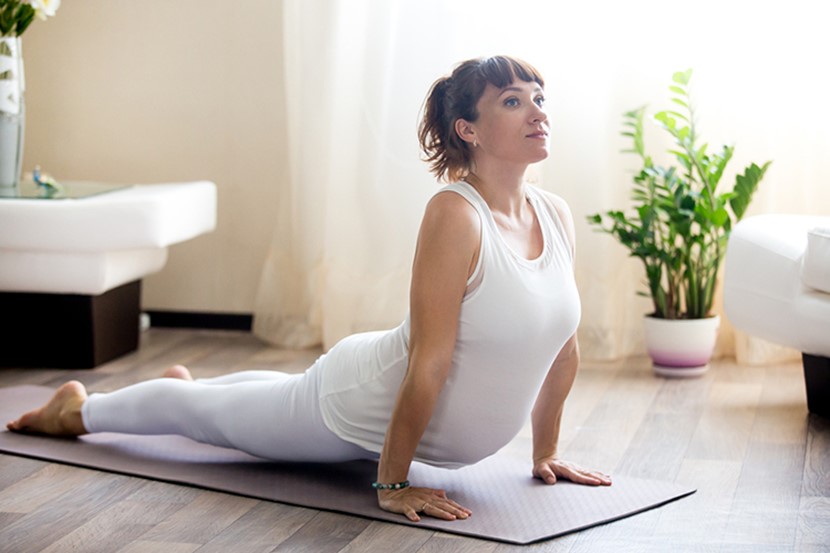How to strengthen your spine and ease back pain in pregnancy

Research shows that women have a stronger backbone than men, and that their lower vertebra is designed to reduce back pain during pregnancy*. However, despite that, up to 70% of pregnant women in the United States still report experiencing lower back pain while pregnant. So how come, even with nature’s amazing help, pregnant women still get sore backs?
Spinal and orthopaedic surgeon Dr. Kenneth K. Hansraj shares these tips for alleviating your spinal pain and help keep your spine in top condition while pregnant.
Exercise
Even just a short walk can help! Walking helps to tighten stomach muscles for a few seconds and then allows them to relax. This tightening and relaxation process help to strengthen the abdominal muscles, which in turn helps provide stability of the lower back. Additionally, walking is great exercise for anyone – pregnant or not – because it works the spinal nerves and spinal facet joints, which are as critical to your overall physical health as all of your other joints. Aquatic/water-based exercises are also a great option for pregnant women, as gravity is not as much of an issue, and will therefore not place any unnecessary pressure on the spine. Read more about pregnancy exercise here
Watch your posture
Due to their shifting centre of gravity, pregnant women usually adjust their posture during the second trimester. I am a huge advocate for always paying attention to your posture. He suggests that pregnant women do their best to try to stand as straight up as possible, without leaning too far back or slouching, as doing so can apply too much pressure to the spine. If pregnant women are having trouble with this, they should ask their physicians about a ‘sacroiliac belt’, which is a supportive device used to stabilise the sacroiliac joint which reduces pain in the pelvic and lower back region.
Correct your breathing
Breath work is critical in pregnancy, and especially recognised using the Lamaze techniques. Breathing moves the spinal nerves, spinal joints and restores spine function.
Sleep and spinal support
You’ve heard it before, but getting plenty of sleep and rest during pregnancy is essential – as is getting the right support, if lower back pain is present. Pregnant women should always try to sleep on their sides, as this is the least pressure-inducing position for the spine. Additionally, women should look into special pregnancy pillows to place between the knees to eliminate additional pressure on the spine while sleeping.
Stretching
Pelvic floor exercises will help decrease stress in the lower back and are a must for all pregnant women.
Wear comfortable shoes
We see countless celebrities wearing high heels during pregnancy. While it may seem cool that they’re attempting to keep up appearances, I think that there is the danger of heels during pregnancy due to a women’s natural gravity shift and the lower back issues that most women experience while pregnant. Wearing high heels is simply an unnecessary risk. Pregnant women should wear comfortable shoes with appropriate support to avoid creating even more pressure on the spine and all other joints for that matter. You can always rock the high heels post-pregnancy!
Get a scan
Women with back pain may consider getting an MRI scan and x-rays before conceiving. This option is no longer available when you are pregnant. I recommend developing a relationship with your spinal specialist who would better be able to support you during pregnancy.
Start physical therapy treatments
Similarly, I suggest beginning treatments with a physical therapist early. During pregnancy, women are typically not recommended to take medications that may hurt the development of the baby. Develop a relationship with a physical therapist during pregnancy that will support with pregnancy massages, modalities and sometimes a deeply relaxing treatment called cranial osteopathy.
Meditation
Meditation can help to diminish stresses and increase the sense of well-being during pregnancy. Meditation will ground you and connect you with your baby who is working as well on the inside.
Yoga
There are many poses that a pregnant woman can do and reap the benefits of relaxation for herself and her baby while maintaining flexibility of the body and especially spine. An account of the pregnant woman’s activity level prenatally needs to be considered when implementing an exercise program of any kind. Care should be taken for the pregnant woman not to overstretch since the hormone relaxin is produced that expands the uterus and softens connective tissue. Also, while performing yoga one needs to listen to her body and gently back off of a pose and never force to the extremes in range of motion. Rhythmic breathing is essential for full benefit as well. Remember to relax, breathe and enjoy your miraculous body!!!
Products to help
The belly serves as a fulcrum to load the spine in non-pregnant patients. With pregnancy the fulcrum enlarges with the growth of a baby. Belly bands, adjustable maternity comfort straps, and maternity belts help to diminish the forces on the lumbar spine. Pillows have been built to increase hip abduction when lying in bed, along with lumbar support memory foam pillows, C-shaped pregnancy pillows and lumbar supports in the sitting position. Find more useful items to help you get through pregnancy.
Dr. Kenneth K. Hansraj is a spinal and orthopaedic surgeon specialising in cervical, thoracic and lumbar procedures.

